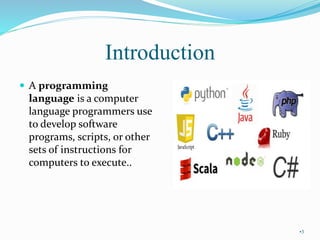Introduction with Programming Language
- 1. 1 Md. Saroar Zahan Sojib ID: 171002011 Dept: CSE
- 2. CONTENT • Introduction • Concept of program • Types of programming language • Translator program • Organization of a program • Steps of developing program • Pseudo code • Algorithm • Flowchart • Conclusion
- 3. Introduction A programming language is a computer language programmers use to develop software programs, scripts, or other sets of instructions for computers to execute.. •3
- 4. i. Variables ii. Control Structure iii. Data Structure iv. Syntax v. tools •4 5 basic concepts of any programming language
- 5. i. Low Level Language ii. Mid level Language iii. High Level Language iv. Fourth Generation Language -4GL •5 Types of programming language
- 6. Low Level Language •6 i. Machine Language ii. Assembly language Machine language example: 10101011 Assembly language example : MOV CX,5 MOV BX,0
- 7. Mid Level Language •7 i. Medium-level language (MLL) is a computer programming language that interacts with the abstraction layer of a computer system ii. Medium-level language serves as the bridge between the raw hardware and programming layer of a computer system. Example: C, Forth, COBOL
- 8. High Level Language •8 i. It enables development of a program in a much more user-friendly programming context . ii. It is generally independent of the computer's hardware architecture. iii. A high-level language has a higher level of abstraction from the computer Example: C,C++,Java, Oracle, Fortran, Python etc
- 9. Fourth Generation Language •9 i. 4GLs are closer to human language than other high- level languages It is generally independent of the computer's hardware architecture. ii. It is accessible to people without formal training as programmers iii. They allow multiple common operations to be performed with a single programmer-entered command Example: Oracle, SQL, Rapport
- 10. Translator program •10 i. Translating the high-level language program input into an equivalent machine language program. ii. Providing diagnostic messages wherever the programmer violates specification of the high-level language program. Example: Compiler Interpreter Assembler
- 11. Compiler
- 12. Organization of a program •12
- 13. Steps of Developing a program •13 Defining and Analyzing The Problem. Designing The Algorithm. Coding or Writing The Program. Test Execution. Debugging. Final Documentation.
- 14. Debugging •14 i. Syntax Error ii. Execution Error iii. Logical Error
- 15. Algorithm •15 i. An algorithm is a step by step method of solving a problem ii. It is commonly used for data processing, calculation and other related computer and mathematical operations. iii. An algorithm is also used to manipulate data in various ways, such as inserting a new data item iv. searching for a particular item or sorting an item.
- 16. Flowchart •16 i. A flow chart is a graphical or symbolic representation of a process ii. Each step in the process is represented by a different symbol and contains a short description of the process step. iii. The flow chart symbols are linked together with arrows showing the process flow direction.
- 17. Example of Algorithm and Flow Chart •17
- 18. Pseudo Code •18 i. Pseudo code is an informal way of programming description ii. that does not require any strict programming language syntax or underlying technology considerations. iii. It is used for creating an outline or a rough draft of a program. Pseudo code summarizes a program’s flow, but excludes underlying details.
- 19. Pseudo Code •19
- 20. Structure of a Program •20
- 21. Example of a program •21 #include<iostream> Using namespace std; Int A=20,b=30; Int main() { int sum; sum = A+b; cout<<sum<<endl; Return 0; }
- 22. Programming is the process of taking an algorithm and encoding it into a notation, a programming language, so that it can be executed by a computer. Although many programming languages and many different types of computers exist, the important first step is the need to have the solution. Without an algorithm there can be no program. •22 Conclusion























